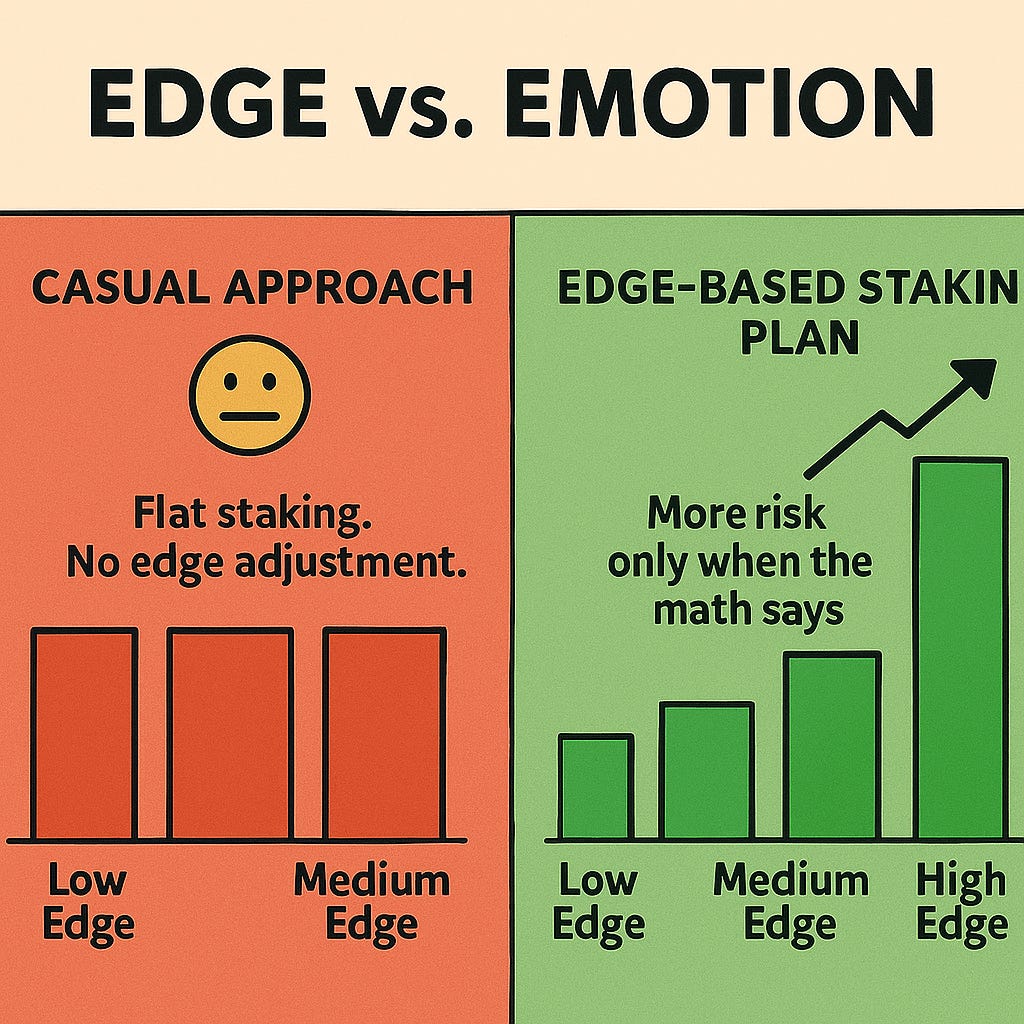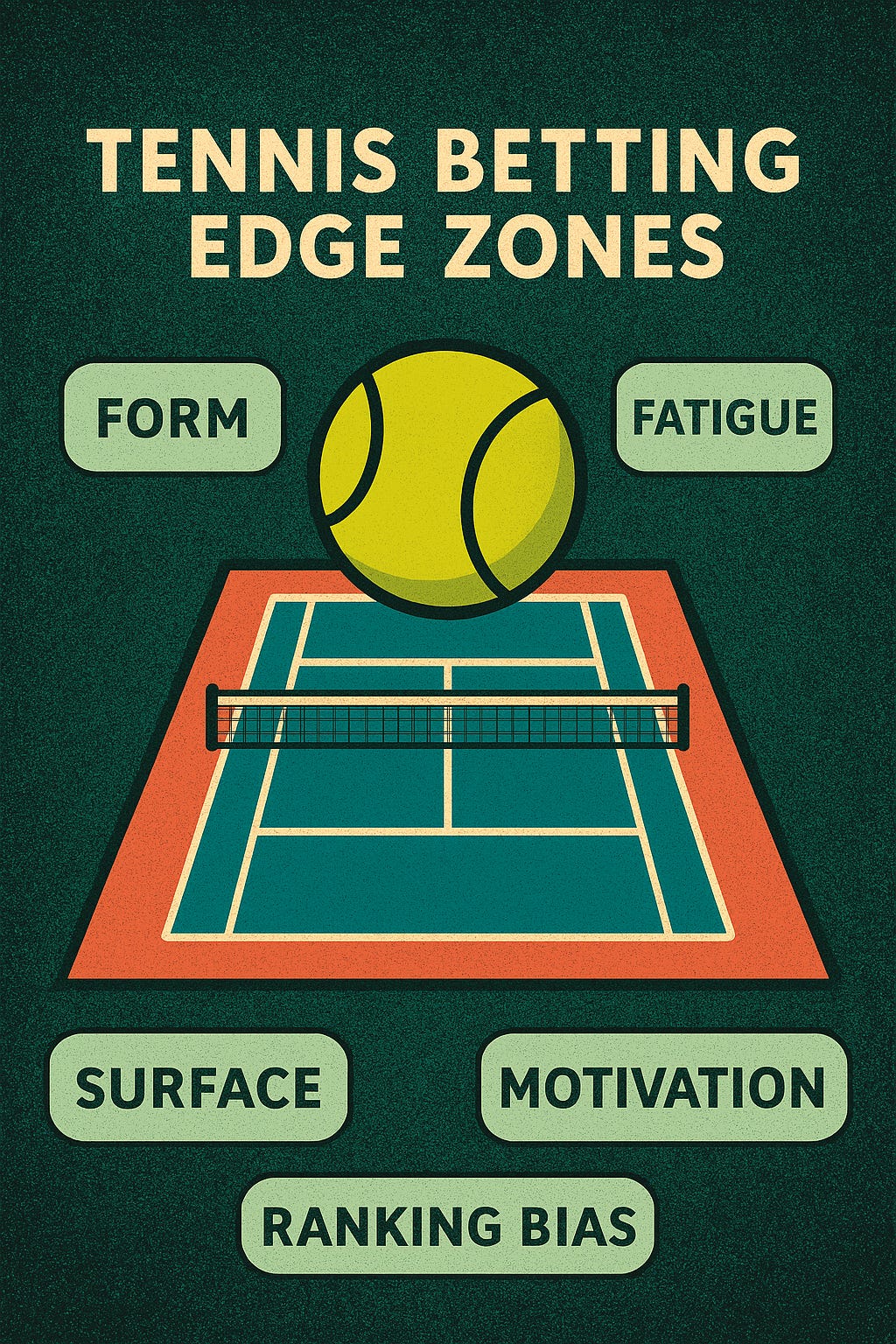The Most Underrated Skill in Betting
Why knowing when to bet big matters more than picking winners.
Can you still learn and improve after decades of betting?
A lot of people think betting success comes down to spotting winners. But here’s a secret most casual punters miss: long-term profitability isn't just about what you bet on—it's about how and when you bet.
That’s especially true when you stumble on a line that just feels wrong. Maybe it's a tennis player priced at 15.0 when form, motivation, and draw say he's in with a real shot. Maybe it’s a popular TV personality flying under the radar in a public vote market. The question is: Do you recognize the edge? And more importantly—do you play it big when it’s time?v
Let’s break down one of the most overlooked betting skills out there.
"You don’t need to bet more often. You need to bet bigger when it matters."
🎯 The Power of Selective Aggression
The edge isn’t in betting more—it’s in betting bigger when the edge is real.
Imagine this: A top-30 ATP player is drawn against a talented young wildcard ranked outside the top 100. The wildcard has home crowd support, has just come off two straight-set qualifying wins, and is playing the best tennis of his life. Meanwhile, the seeded player has flown in from another continent, just finished a grueling clay-court swing, and is clearly not comfortable on the current hard court surface.
The market opens with the top-30 player priced at 1.40, but your read—factoring travel, surface adjustment, momentum, and motivation—makes this much closer to 1.80 vs. 2.00.
That’s your edge. The market is anchored on rankings, but rankings don’t travel. You do.
That’s not just a bet—it’s an opportunity. And it’s how serious bettors build their bankrolls.
The key here? Treat big edges like they’re rare diamonds. Because they are.
📉 Don’t Fall for the Price Anchor Trap
There’s a common trap that destroys value: focusing on what could have been.
“I missed it at 17.00, so I can’t back it now at 2.00.”
Wrong mindset. Every market moment is fresh. The only thing that matters: What’s the value now?
Whether you’re betting sports or novelty markets, ignore the ghosts of past prices. Anchor to present value, not regret.
💻 Why Algorithms Alone Aren’t Enough
We live in a world of data. Everyone has access to xG, possession stats, and price movements. But data has limits:
Computers don’t know when a player is 39 and fading fast in the second set.
Algorithms can’t model public affection in a voting show.
No model factors in that last-day-of-season weirdness where “nothing to play for” becomes everything to play for.
Human insight still matters. In fact, it may be more valuable because the markets are so efficient elsewhere.
🧠 The True Mark of Betting Maturity
Want to know when most bettors improve? It's not when they discover a new model. It’s when they:
Learn not to chase losses
Avoid betting emotionally
Accept that skipping a week is not missing out
Know how to size stakes based on edge, not feeling
Some call this being a “grinder.” Others call it boring. But it’s how you survive long enough to thrive.
👉 If you’re betting more when you’re losing and pulling back when you’re winning, you're doing it backwards.
🧠 From Chaos to Control: The Confidence Curve of a Smarter Bettor
If there’s one trait that separates lifelong bettors from weekend warriors, it’s not IQ or models—it’s emotional control.
Most of us start out betting with raw enthusiasm and zero structure. Big highs, big lows. But as the years go by, something changes:
You stop chasing bad prices
You accept skipping a day—or a week—isn’t weakness
You realise the best bets aren’t always exciting—they’re just +EV
Over time, your approach matures. You get calmer after losses. Greed doesn’t control your stakes. And “having no bet today” starts to feel as satisfying as finding a good one.
💡 Mental model: Think of your betting journey like a curve—early chaos followed by a plateau of professionalism.
The longer you last in this game, the more you understand: it's not about thrills. It's about edge. Patience. Resilience.
That’s how you stay in the game—and eventually win it.
🎾 Where the Edge Lives: Spotting Market Mistakes in Real Sports
Edges don’t just appear—they hide in overlooked corners of the market. And one of the best places to find them? Tennis.
Unlike team sports, tennis offers:
Clear form lines (one-on-one matchups)
Frequent schedule congestion
Strong situational factors (travel fatigue, surface changes, weather, motivation)
Let’s say a top-ranked player just played a five-set thriller in sweltering heat. Two days later, they’re priced as a heavy favourite against a rested, in-form opponent. The market often underprices fatigue and overvalues rankings.
Or consider a young player rising quickly through the ranks—winning Challenger events, performing well in qualifiers—but still getting priced like a journeyman. That’s a classic early-season value opportunity.
Other examples of market inefficiencies:
Late-season motivation (e.g. players chasing points for Tour Finals qualification)
Surface specialists who thrive on clay or grass but get mispriced on hard courts
Veterans who start strong but consistently fade in long matches—an edge in live markets
The more you understand the sport’s rhythms, the better you can anticipate when the price doesn’t reflect reality. And when that happens, it’s time to stake with purpose.
📈 Yes, You Can Still Learn—At Any Age
Maybe you’re not building betting models in Python or optimizing line movement charts in real-time. That’s fine.
If you can:
Spot mispriced narratives
Understand timing and momentum in markets
Stay disciplined and detached
You can win. That’s not just about betting—it’s about growing as a decision-maker.
🎯 The Bottom Line
Betting smart isn't about betting more—it's about betting well. Learn to recognize when the edge is big enough to matter and have the courage to play it.
And when things go wrong?
Stay calm, stay disciplined, and come back sharper next week.




